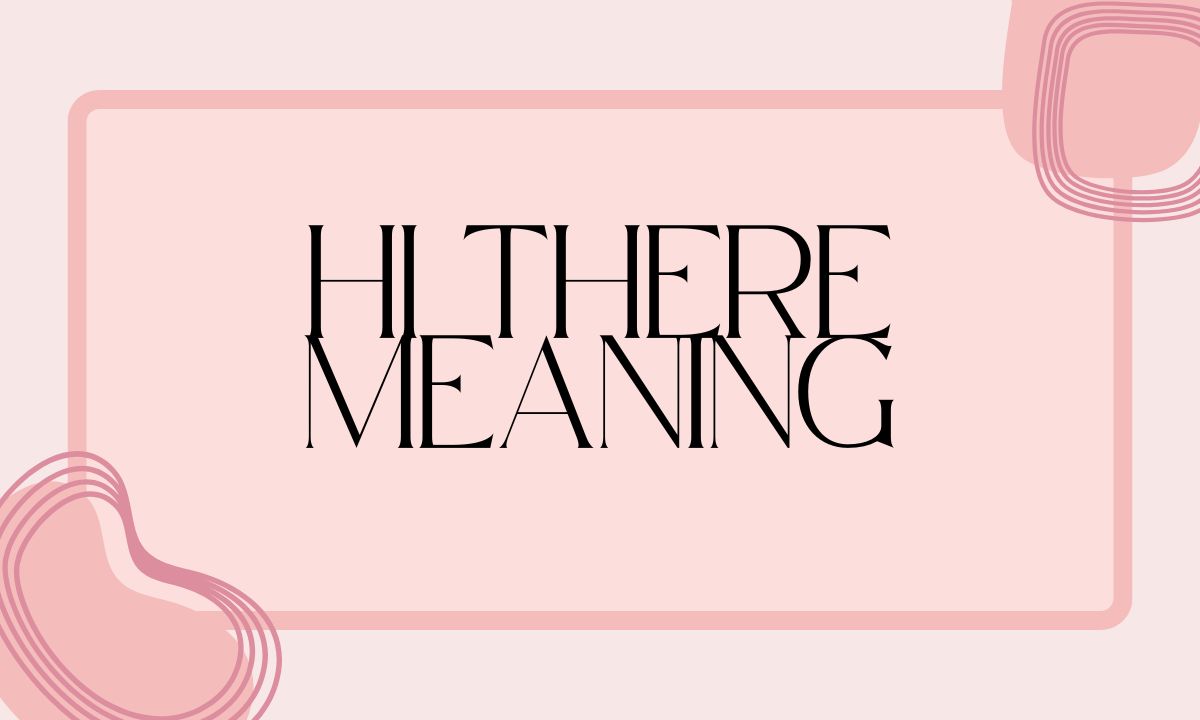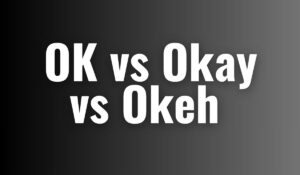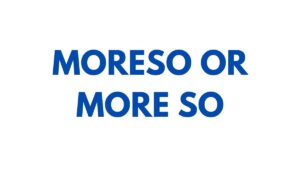Hi There a phrase we use almost daily is far more than a casual hello. This short greeting carries warmth, friendliness, and a subtle emotional tone. It’s often used in casual conversations, customer interactions, or friendly messages to make communication sound more human and open.
Understanding what makes “Hi there” unique helps you choose when to use it whether you’re chatting with a friend, writing an email, or greeting someone for the first time. Let’s explore its meaning, origin, pronunciation, examples, and real-life usage to help you master this simple yet powerful phrase.
What Does “Hi There” Mean?
The expression “Hi there” means a friendly, informal way of saying hello. The word “Hi” acts as a simple greeting, while “there” adds warmth and attention as if you’re acknowledging the person directly. It’s a phrase you’ll often hear in daily English speech, used to start conversations naturally.
For example, a customer service email might begin with “Hi there!” to sound inviting. Though casual, it’s also polite enough for many semi-formal situations. In essence, “Hi there” helps create a connection that feels approachable and human, bridging the gap between friendliness and professionalism.
The Role of “There” in the Phrase
When you say “Hi there,” the word “there” doesn’t refer to a literal place. Instead, it serves a social purpose softening the tone and making your greeting feel more personal. It’s an adverb, but in this context, it carries emotional warmth. Compare these two: “Hi” vs. “Hi there.” The second sounds gentler, more attentive, and more expressive.
Linguists call it a phatic expression, meaning it’s used for social bonding rather than direct meaning. This small word adds nuance, helping you sound less robotic and more genuinely engaged in your interactions.
Grammar and Structure of “Hi There”
Grammatically, “Hi” is an interjection, expressing a greeting, while “there” functions as an adverb that modifies tone. Together, they form a short sentence that stands alone, often punctuated with an exclamation mark: “Hi there!” Some people mistakenly write “Hi, there” with a comma, but modern grammar guides recommend omitting it for a smoother, conversational flow.
Phonetically, it’s pronounced /haɪ ðɛər/ and flows naturally in speech. This phrase belongs to the class of phatic communication, emphasizing friendliness over literal meaning, making it an ideal choice for casual messages and friendly conversations.
How “Hi There” Differs from “Hi” or “Hello”
While “Hi” and “Hello” are universal greetings, “Hi there” carries an added layer of personality. Saying just “Hi” feels neutral polite but minimal. Adding “there” introduces warmth and approachability.
For instance, a text saying “Hi there!” feels livelier and friendlier than “Hi.” The difference may seem small but has psychological value. In customer relations or social media interactions, “Hi there” helps you sound more human and caring. Think of it as a bridge between professional politeness and casual comfort, perfect for informal business emails or friendly digital conversations.
When Should You Use “Hi There”?
You can use “Hi there” in many everyday situations. It’s best suited for informal or semi-formal contexts, such as chatting with coworkers, replying to customers, or messaging someone casually. It works well in greetings like:
- “Hi there! How can I help you today?”
- “Hi there, long time no see!”
However, it’s better to avoid it in highly formal settings like legal letters or official applications. In those cases, stick to “Dear [Name]” or “Hello.” The key is matching tone with the setting. “Hi there” works perfectly where friendliness and professionalism meet.
Examples of “Hi There” in Real Conversations
| Context | Example | Tone |
| “Hi there, thank you for reaching out!” | Friendly | |
| Text Message | “Hi there! How’s your day going?” | Casual |
| Customer Chat | “Hi there! I’m here to help you.” | Professional but warm |
Each example shows how “Hi there” makes interactions sound approachable without crossing into over-familiarity. It sets a positive tone from the start, especially when paired with polite expressions like “How are you?” or “Hope you’re doing well.”
Quote: “A friendly greeting can change the direction of any conversation.” – Anonymous
Common Mistakes to Avoid
While “Hi there” is easy to use, there are a few mistakes people make:
- Using it in overly formal contexts. It can sound unprofessional if the setting is too serious.
- Adding unnecessary punctuation. Avoid writing “Hi, there.” the comma is unnecessary.
- Overusing it in every email. Repetition can make it lose sincerity.
- Ignoring context. If someone writes “Hello” formally, responding with “Hi there” may feel too casual.
Remember: tone, setting, and relationship determine whether this greeting fits naturally.
The Psychological Impact of Saying “Hi There”
Words influence emotions, and “Hi there” carries a subconscious emotional effect. It signals friendliness, openness, and attentiveness qualities that make others feel valued. Linguistic studies show that phrases with personal elements like “there” trigger a warmer emotional response.
For example, in customer service, agents who start with “Hi there” often receive more positive replies. The phrase softens the atmosphere, reducing social distance. When you use it genuinely, it humanizes digital interactions, creating an instant sense of comfort and connection something that plain “Hi” often fails to do.
“Hi There” in Pop Culture and Media
You might recall Obi-Wan Kenobi’s famous line, “Hello there!” from Star Wars. Over time, similar greetings like “Hi there” have become part of pop culture, appearing in songs, memes, and movies. It’s often used by characters to show confidence or warmth.
In email marketing or branding, “Hi there” gives off a friendly vibe that attracts readers instantly. Many businesses now start newsletters this way to sound human rather than corporate. Its informal charm bridges the gap between casual tone and professional outreach a perfect blend of friendliness and approachability.
Cultural and Regional Variations
Across regions, the use of “Hi there” varies slightly. In American English, it’s extremely common and considered polite in both digital and spoken form. In British English, alternatives like “Hiya” or “Hello there” might be more frequent. In Asian English-speaking regions, including India and Pakistan, “Hi there” appears mostly in emails, online chats, or informal workplaces.
Despite differences, the meaning remains consistent friendliness. It reflects global communication trends, where warmth and approachability are now valued as much as formality.
How to Respond to “Hi There”
When someone says “Hi there,” your response sets the tone. You can reply with equal warmth:
- “Hey there! How are you?”
- “Hi! Nice to hear from you.”
- “Hello there! Hope everything’s good.”
It’s polite to mirror the sender’s tone. If they sound casual, respond similarly. In formal exchanges, adjust slightly by saying “Hello” or adding their name. The key is maintaining friendliness while respecting context. This small effort can make digital communication more authentic and engaging, leaving a positive impression every time.
Case Study: Email Greetings That Boost Engagement
A case study from HubSpot shows that emails starting with friendly greetings like “Hi there” achieved a 12% higher response rate than those beginning with “Dear Customer.” The reason is simple people connect better with genuine, conversational tones. In customer service, saying “Hi there” instantly humanizes the brand voice.
Whether you’re emailing a client or posting on social media, the right greeting builds trust. Hi there stands out because it feels natural, universal, and friendly exactly the tone modern digital communication needs.
The Emotional Layer Behind “Hi There”
“Hi there” carries an emotional undertone that transcends words. It’s soft, open, and subtly affectionate. Unlike a robotic “Hello,” it signals warmth and familiarity. This emotional nuance helps establish trust, making the receiver feel noticed and appreciated.
Psychologically, it activates feelings of belonging and friendliness, which is why customer service agents often use it. Whether online or in person, adding that “there” turns a basic greeting into a welcoming moment one that builds immediate rapport and comfort.
The Evolution of “Hi There” in Modern Communication
Over decades, “Hi there” evolved with digital communication. Earlier, it was mostly spoken in person, but now, it dominates emails, social media posts, and chatbots. Its rise coincides with the trend of making brands and messages feel more “human.”
Modern AI assistants, such as Siri or Alexa, even open conversations with greetings similar to “Hi there!” This evolution shows the importance of emotional intelligence in communication we now value warmth over rigid professionalism, making this phrase timeless and adaptable.
Why “Hi There” Will Always Remain Relevant
Despite technological advances, some words never lose value and “Hi there” is one of them. It remains a simple yet effective bridge between humans, machines, and culture. As communication grows faster and more digital, phrases like this keep language human-centered. It’s friendly, concise, and emotionally rich everything modern conversation needs.
Whether in a chatbot greeting, business email, or text message, “Hi there” effortlessly maintains its charm. That’s what makes it more than a phrase it’s a universal connector that stands the test of time.
Conclusion
Hi there is more than a phrase it’s a gesture of warmth and connection. From casual chats to customer emails, it strikes a perfect balance between friendliness and professionalism. Understanding its tone, meaning, and proper context ensures you communicate naturally, respectfully, and effectively.
In a world dominated by screens and automation, a simple “Hi there” keeps our conversations human, approachable, and emotionally intelligent. Use it wisely and you’ll notice how such small words can make big differences in how people perceive you and your message.
FAQs About “Hi There”
What does “Hi There” really mean?
“Hi there” is an informal greeting used to say hello in a friendly and approachable way. It combines “Hi” (a simple greeting) with “there,” which adds warmth and attentiveness. The phrase makes conversations sound natural and welcoming.
Is “Hi There” formal or informal?
“Hi there” is considered informal or semi-formal. It’s perfect for friendly emails, texts, and casual interactions but not suitable for official or legal correspondence. For formal situations, use greetings like “Dear [Name]” or “Hello.”
Can I say “Hi there” in an email?
Yes, you can say “Hi there” in an email, especially when writing to clients, colleagues, or new contacts in a relaxed tone. It sets a friendly, human-like atmosphere that encourages conversation, but avoid it in very formal or academic emails.
Should I write a comma in “Hi there”?
No, you generally shouldn’t add a comma between “Hi” and “there.” The correct form is “Hi there!” without a comma. Including a comma (“Hi, there”) can make the sentence feel awkward or old-fashioned in modern English writing.
What’s the difference between “Hi there” and “Hi”?
The difference lies in tone. “Hi” is simple and neutral, while “Hi there” adds warmth and friendliness. Saying “Hi there” makes your greeting feel more personal and engaging, which is why it’s often used in emails or social messages.
How should I respond to “Hi there”?
The best response is to match the sender’s tone. You can reply with “Hi!” or “Hey there!” if the situation is casual. In semi-formal settings, replying with “Hello, nice to hear from you!” keeps the conversation polite and balanced.
Is “Hi there” grammatically correct?
Yes, it is! “Hi there” is grammatically correct and widely accepted in English. “Hi” is an interjection, and “there” acts as an adverb to soften the greeting. It’s a common expression in both spoken and written English.
When should I avoid saying “Hi there”?
Avoid using “Hi there” in extremely formal contexts such as job applications, academic papers, or official letters. In those cases, a simple “Hello” or “Dear [Name]” fits better. The phrase is best suited for friendly or conversational exchanges.
Why do people say “Hi there” instead of just “Hi”?
People often use “Hi there” because it feels more personal, emotional, and less robotic. Adding “there” gives the greeting a sense of attention and inclusion, which helps start conversations on a warmer note.
Is “Hi there” rude or polite?
“Hi there” is polite and friendly in most cases. It’s a respectful way to greet someone casually. However, tone matters a flat or sarcastic delivery can sound dismissive. Used sincerely, it conveys warmth and openness.








